My all-time favorite Japanese knotweed recipe, these fermented pickles are a must if you have access to this plant. Read on and I'll explain why it will change your knotweed foraging game.
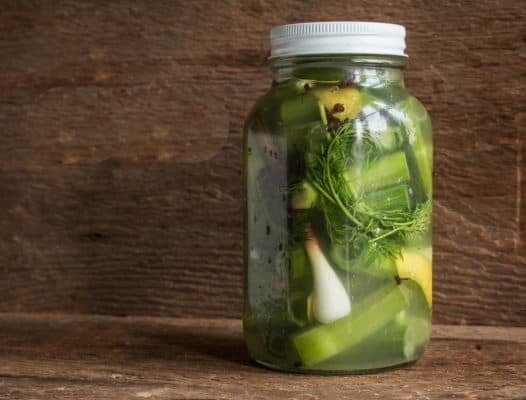
One of the best parts about this site I never would've imagined as it was hatched when I lived in my friends basement years ago was that I'd be able to talk to people outside of the Midwest. In hindsight, the Internet being, well, the Internet, I should've known, but it came as a real surprise when I started trading information on my favorite plants and mushrooms with people literally around the world in real time.
One of my favorite foragers I've never met is my friend Jacqui, who lives across the pond in France, and without her, I may have never tried brine fermenting Japanese knotweed--which I now agree is arguably the best way to preserve the fresh tender stalks for savory uses. Thanks Jacqui.
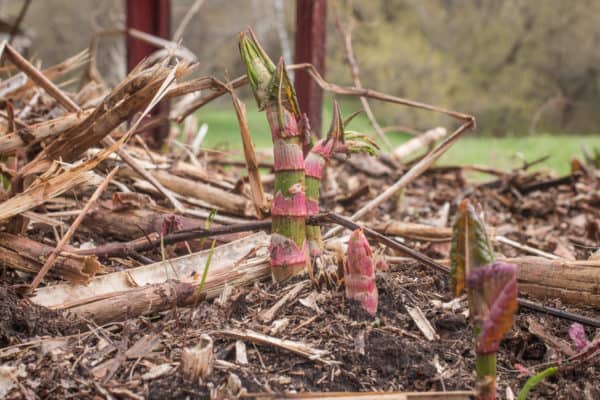
Most of the time if I work with Japanese knotweed (Reynoutria japonica and other synonyms) it's going to be a sweet application, which will probably involve me pureeing it with cooked apples which helps smooth out the flavor knotweed afficionados might describe as swamp rhubarb or some type of sorrel-esque something.
Puree is easy to work with, removes any stringy fibers if you get greedy and harvest older stalks (especially if strained) and is more pleasing to the eye than the soft mushy chunks of knotweed you'll get cooking the plant fresh.
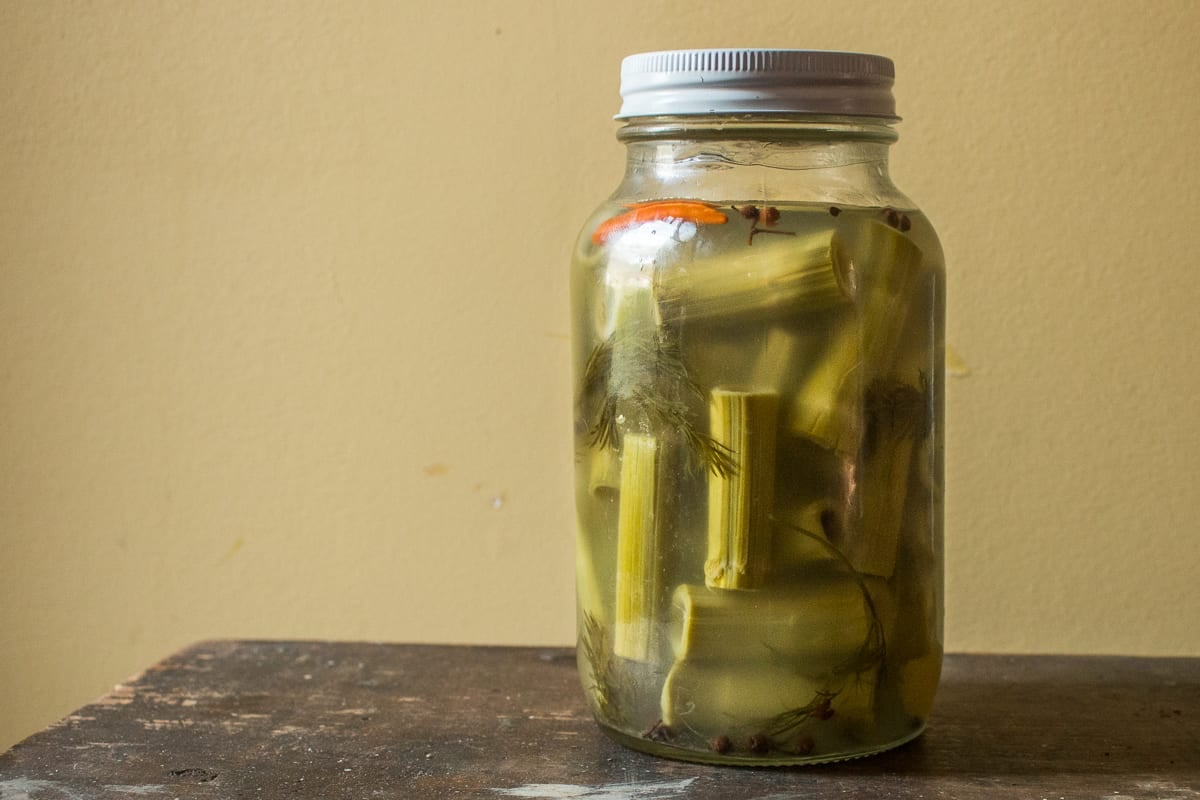
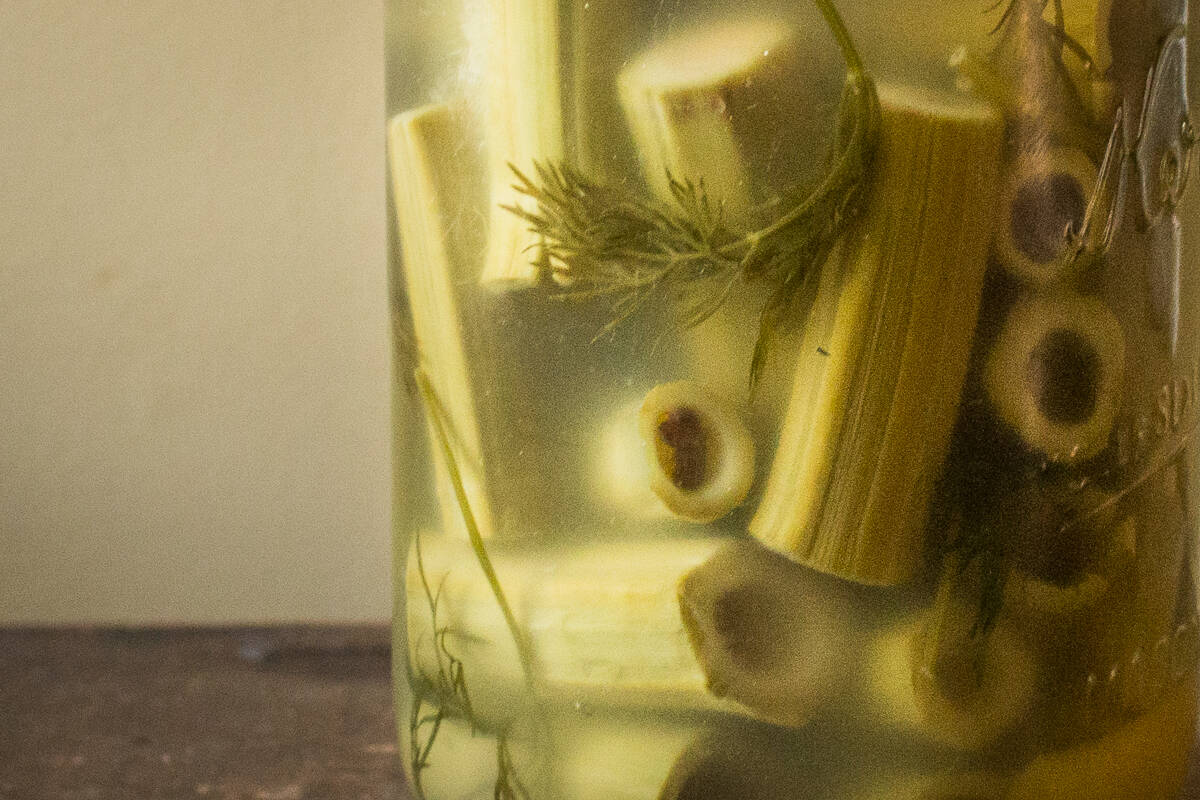
Brine fermentation doesn't activate mucilage
The interesting thing here, and really the reason that lacto-fermenting knotweed is complete magic, at least for me, has to do with mucliage. Knotweed is one of the most mucilagenous plants I know of. Seriously, the plant should come with a tag reading: "Our condolences on finding knotweed near you.
This plant is a gremlin: don't feed it after midnight, and absolutely, positively, don't get it wet". Most of the time with mucilage, as with okra or other plants in the Malvaceae (mallow, violets, etc) I think of it being released from cooking, but dip fresh cut knotweed stalks in water, you can see thin, mucligenous tendrils dripping immediately from the cut fresh stalks.
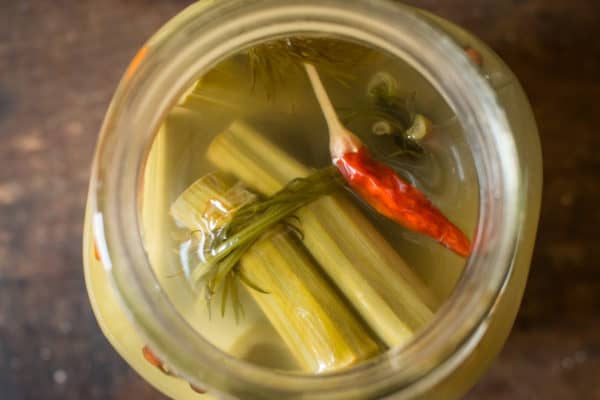
There really seemed to be no way around the Slimer effect, and pickling was out for me as even cold pickled stalks made goey liquid overnight, although it wasn't anything insurmountable. Brine the stalks though, and for whatever reason, there will be no mucilage--zero, and the stalks will keep a pleasant crispness as they ferment and gradually sour.
Add a few seasonings along the lines of a kosher dill pickle recipe, and you have a edible project knotweed virgins will happily eat (preferably under the name pickled Japanese rhubarb) and that even I, sworn to sweet knotweed recipes as I once was, will happily eat. Classic dill pickle spices and seasonings are really good here, and the only break from that tradition I chose was a good teaspoon of wild Szechuan peppercorns / Xanthoxylum / prickly ash berries.
The finished pickles are great with a slice of fish, as a condiment to ramen in place of fermented bamboo, or, as Jacqui suggests, mixed into some simple fish cakes. If you have knotweed near you, definitely give a quart jar a go.
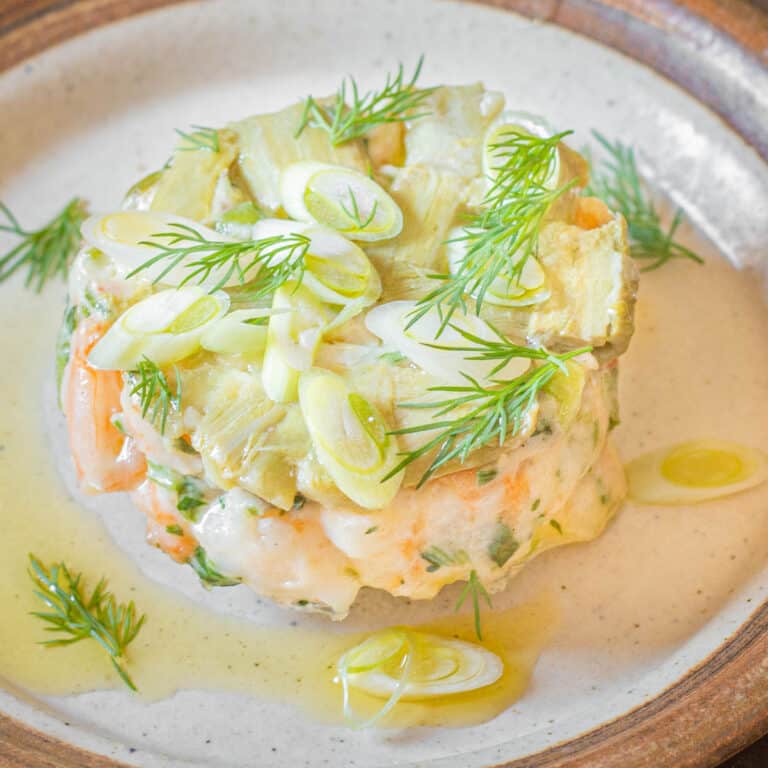
Tips
- You want thick, chubby shoots here--look to older knotweed patches near the epicenter.
- For the best texture and flavor, peel the knotweed. If your shoots are thin, this may not be possible. Unpeeled shoots will still ferment fine, but won't be as good as peeled thick shoots.
- This is just a guide for a quart jar, so scale it up for your needs and modify to your tastes. Dill, lemon, garlic and hot chili is an excellent places to start though.
More Knotweed
Japanese Knotweed: Hunting, Harvesting, Cooking and Recipes
Fermented Knotweed Pickles
Equipment
- Quart mason jar
Ingredients
- 280 grams (10 oz) Young knotweed shoots, peeled, tips discarded preferably thick chubby ones under 1 ft tall
- 550 grams (scant 2 cups) water
- 24 grams (2 Tablespoons) Kosher salt 3% salt
Seasonings (adjust to your taste)
- 4-5 sprigs of fresh dill
- 1-2 fresh garlic cloves I used a ramp bulb
- 1 teaspoon black peppercorns
- 1-2 small hot chilis or equivalent
- a couple strips of lemon zest
- 1 teaspoon dried wild Szechuan peppercorns (prickly ash berries)
Instructions
- Cut the the shoots into 3-4 inch pieces, toss with the remaining ingredients except the water and salt, and pack into the quart jar. Mix the salt and water until dissolved, then pour over the contents of the jar.
- Screw on the lid(s) and leave out, opening the jars occasionally to burp them. The knotweed pickles will begin to sour in a few days, and develop good flavor after only a couple days in the brine at room temperature. They can be refrigerated, or stored at room temperature, like classic kosher dill pickles.
- To use the pickles, take them out of the jar and cut into slices, or whatever shape you like. I like thick tubes, since they give me more freedom and control over future cuts and sizes, but you could sure cut them into slices or chunks so they could be spooned out directly from the jar and used.


z
How long are they good at room temperature? Would the flavor keep changing? I usually can things for gifts but it seems like that's not recommended for lacto-fermented items I guess because of texture.
Alan Bergo
A very long time, as long as they're covered with liquid.
idgod
Simply want to say your article is as astonishing. The clarity on your submit is simply spectacular and that i can suppose you're knowledgeable on this subject. Fine along with your permission let me to grasp your RSS feed to keep updated with imminent post. Thank you one million and please carry on the gratifying work.|
Alan Bergo
Hey thank you.
Reid
This is a great recipe, thank you! I have done about 5 fermentations and have had success on all of them. I do not peel the knotweed, and have been using larger stalks (still young, but not just the shoots - they grow so fast that they are still quite tender). Delicious, snappy, and not fibrous at all. The knotweed has such a nice herbaceous flavor that is so tasty with the peppercorns. I eat them right from the jar. Such a treat in early spring!
Alan Bergo
Hey thanks so much Reid. I'm going to make a note on the peeling, I have access to big, thick shoots that are easy to peel but I know a lot people only get thinner shoots.
Reid
Great recipe, super clear, and freaking delicious results. No slime at all and crunchy. I used thinner knotweed shoots and did not need to peel them. I also fermented them for about a week and found they had a lovely flavor. Thank you for the inspiration!
Alan Bergo
I know it's like "this is knotweed!?". Glad it worked for you.
Reid
so good i had to review twice! haha
Calvin
Great recipe, I made my first couple of batches and noticed that some of the knotweed chunks that are sticking out of the brine are growing some white/green mold. Is it still safe to eat the rest of them if I remove the moldy bits and toss them? Thanks!
Jacqui
absolutely. Sometimes, in old jars, the top-most layers can go a bit mushy-slimy but the parts underneath are still perfectly fine and safe. It seems that nothing bad will tolerate a 3% brine. And the mold itself is nothing to worry about. It should be discarded but it's not making any toxins.
Jacqui
and a clean rock or a glass weight or a jar or drinking glass that fits into your jar mouth will keep bits from sticking out of the brine...
Guy
And no mention of the magical Resveratrol? Likely one of the most potent longevity nutrients out there - same as is found in red wine except in much much higher concentrations. These pickles may just add a few years to your life!
Alan Bergo
If you were me you probably wouldn’t mention it either. I talk about food here, and only food, since speaking about medicinals can become a quagmire, quickly. I appreciate the plant, but I leave divining health benefits from it, no matter how “well known” they are, to readers.
Guy Follen
Yes, good point. There are a bounty of other pages that deal with all that.
Claire
Greetings! Of courseI stumbled on this way after our polygonum spp have leapt to shoulder high height. In Seattle, the rain and rapidly increasing day length means the shoots become waist high canes in about two days, so shoot forage window is brief. Do you think it is worth trying with the growing tips?
We have three species here...Polygonum sachalinense, Polygonum cuspidatum and Polygonum x bohemicum which is a hybrid of the previous two.
I make a resveratrol rich tincture of the roots of P. x bohemicum as that is what grows closest to me, the true japanese knotweed being harder to find as it is rather promiscuous and hybridizes.
Are you familiar with misozuke? miso pickled vegetables? That might be another way to keep the mucilage from getting activated. I am going to try doing that to fresh growing tips of polygonum. I tried with some blanched Pteridium aquilinum but I I did not care for it. Also, I think you would love this video of a Japanese grandma doing her sansai pickling with foods she still forages from the mountains even though she is in her 80s https://www.youtube.com/watch?v=NRm5MF89mpQ
And if you have not seen any of the various youtube channels of young chinese women who forage, grow, cook traditional chinese recipes, then you need to check them out! Here is a good place to start: green jelly from some leaf (cannot tell what plant she is picking from as I do not read chinese) https://www.youtube.com/watch?v=B9r3zjtkRxk
Peace, thanks for your work and blog posting.
Alan Bergo
Thanks Claire. As far as knotweed tips, no, I wouldn't do it with them, even if they're tender and nice. Well, ok, if you strip all the leaves off, maybe it would be palatable--I do not like the leaves. Otherwise, remember for next year. Honestly it's the best savory application for knotweed I've tasted yet--and still crisp after months in the pantry.
Bill McDuff
Alan, Thanks for the recipe it's much appreciated. There's a decent sized patch of Japanese knotweed in a nearby park and will probably pick some tomorrow and give the fermented version recipe a try. Regards from Canada Bill
Jacqui
Gosh Alan, thanks. I'm really glad you like the pickles.
I actually broke confinement a couple of weeks ago to take a big jar of lactofermented knotweed stems to my research group's lab technician who is particularly fond of them. I met her in her parking lot for an illegal jar drop. It felt like a drug deal.
But the knotweed stems also can be worked into killer chutney (lots of onions, garlic, ginger, hot peppers, fenugreek, cardamom, tamarind if you have it, and enough salt and vinegar...) and the mucilage is not an issue in the chutney. I'm always looking for found ingredients to keep the costs down for the restaurant I provide with chutneys and preserves, and the knotweed chutney is a real favourite. The restaurant has just converted to a take-out only model so though the front room staff are gone (my daughter among them), the kitchen is up and running again after a month and a half in the twilight zone. And many Parisians are desperate for food they have not cooked themselves, so it is going well.
How do you and your colleagues imagine the "restaurant of the future"? Maria thinks that a full meal take out kit, sous vide, for a no-fuss but interesting dinner at home is far more appealing than dinner in a plexiglass box with a screen between you and your dinner companion...
I am so glad, for so many reasons, that I know how to cook. It must be awful for those who do not...
Alan Bergo
Ugh. The outlook is bleak. The restaurant I was working with last year, and had just announced our partnership for another year, put out the press release last week that they are closing forever. The restaurant was owned by the descendants of John D. Rockefeller, so if they don't have the money to make it work, I don't know who does (I suspect there are some kind of other circumstances in play there). Not a lot of options, and I'm glad im not in a resto right now. 50% capacity is a joke, as is 75% for most places. Even after places open up, I have no idea how people will feel about going out in public, I, for one, am happily cooking at home and don't really like to go out anyway. It's going to get more weird before it gets better, I think. Thanks again for turning me on to fermenting the buggers--I'll have to try some chutney.
Jacqui
For the knotweed, I brine them overnight before I chutney them. This is probably unnecessary but it's what my Dad always did for his chutneys and sweet pickles (watermelon rind, too-ripe cucumbers ... (speaking of which, does your Danish grandmother make "Asier Pickles"? This is the closest thing to watermelon rind pickles I have ever eaten. It;s made of the cucumbers you didn't see till to was too late and is a mainstay of traditional Danish cuisine).
And the knotweed really makes an excellent chutney. Knotweed being something you can have in unlimited quantities it seems silly not to take advantage of the abundance and turn it into something useful.
I am so sorry to hear about the restaurant you worked with. My heart goes out to everyone in the industry, and in a lot of other industries too... Alain Ducasse has proposed (ludicrous to my mind) plans of what a restaurant could look like in the future, with each table basically cordoned off in a plexiglass box or bubble with transparent screens to isolate each person. Very romantic as well as being impossible for the business model we had, where pretty much every square centimetre of space had to be used usefully all the time. I cannot imagine that this will fly.
Ellen
I'll try this next time! Interestingly, I've picked knotweed stems multiple times (refrigerator pickles) and never gotten the mucilage. Do you peel yours? I don't, and it looks like you might, so I'm wondering if that would make a difference.
Ellen
ok, and I meant pickled, not picked (although that, too).
Alan Bergo
Yep. I peel them, I prefer lacto fermented to vinegar based by far. I don't think peeling would make a difference. There isn't tons of mucilage with cold vinegar pickles I've made, but I still noticed some, moreso in the liquid. I used to have cooks drain it before serving and it worked out ok, just not as good as lacto IMO.
Carla Beaudet
Alan, we must have tried this simultaneously, both inspired by Jacqui. Merci beaucoup pour l'inspiration, Jacqui! But I had only younger knotweed to work with, and I didn't peel it, thinking it was so tender to begin with, why bother? It turned out surprisingly well, but the outermost layer is, in fact, slightly tougher, and I think, like you discovered, the better way to do this is take fatter stems and peel them. But no mucilage, even without peeling. I'm going to repeat the experiment if I get out and harvest any more knotweed this season, using the longer, fatter stems, and peeling them. It froze pretty hard last night, likely killing what came up so far, so I expect there will be more opportunity.
Alan Bergo
Yeah it froze hard here too, fiddleheads, and most of the knotweed on the farm got cold-kill. I definitely prefer it peeled, takes some time but it's worth it.
Carla Beaudet
Ok, round II the following year. Picked the bigger stalks and peeled them. I agree, even better, and definitely prettier. Been thinking of stuffing high quality canned tuna, or a tuna salad made with the same, into the tubes. They kind of beg to be stuffed. Any ideas?
Jacqui
Hi Carla. I have stuffed the (fresh, raw, unpickled) fat stems with ground fish mixed with some egg, breadcrumbs, combava leaves, lemon grass and fish sauce or thai curry. I also stuffed some with ground porc, garlic and ginger and I stuffed some with ricotta, vanilla and raisins. Baked in the oven these were great. On the other hand it was way way more work than just baking little fish cakes mixed with chopped knotweed stems or making a knotweed cheesecake. I mean it was fun to do once, but there are easier ways to get the same flavour.
Fishcakes with a bunch of chopped knotweed folded into the paste and baked in muffin cups is now one of my mainstays and a great way to use up left-over fish. You can add coconut milk or not, different kinds of spices... it's the best.
Carla Beaudet
Hi Jacqui, great ideas all...but what about the slime factor? Without the lacto fermentation, won't the knotweed lend a pretty slimy texture? I guess I should just try it and see what I think of it?
Jacqui
I didn't find the slime (let's call it mucilage...) annoying. In the fish cakes you won't notice a thing. With the baked stuffed knotweed tubes it was really not an issue. For the sweet version it just contributed to the syrupy sauce leaks. For the savoury ones it was just like having a bit of gelatine. If you serve the tubes warm you won't notice at all.
I know Alan uses the fermented pickles in his fish cakes but I have just used fresh chopped from the start and it works for me.
Carla Beaudet
Thanks, Jacqui; I will just have to try a baked, stuffed, savory preparation and see what I think of it. People have very different tolerances when it comes to slippery foods. I am fairly adventurous, but grated nagaimo, for instance, is not an experience I've sought to repeat.
Alan Bergo
Thanks for chiming in Jacqui. Let me say again, THANK YOU for reminding me about the lacto method, it's sooo good.